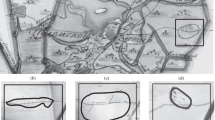Abstract
In order to detect targets from the hyper-spectral images captured by unmanned aerial vehicles, the images are moved into a new characteristic space with greater divisibility by making use of the manifold learning theory. On this basis, a furation impulse response (FIR) filter is developed. The output energy can be minimized after images passing through a FIR filter. The target pixel and the background pixel are distinguished according to the restrained conditions. This method can effectively suppress noises and detect sub-pixel targets in the hyper-spectral remote sensing image of unknown background spectrum.
Similar content being viewed by others
References
Schowengerdt R A. Remote Sensing: Models and Methods for Image Processing[M]. 2nd ed. New York: Academic Press, 1997.
Chang C I. Hyperspectral Imaging: Techniques for Spectral detection and Classification[M]. Dordrecht: Kluwer Academic/Plenum Publishers, 2003.
Chang C I. An information theoretic-based approach to spectral variability, similarity and discriminability for hyperspectral image analysis[J]. IEEE Trans on Information Theory, 2000, 46(5): 1927–1932.
Chang C I, Brumbley C. Linear unmixing Kalman filtering approach to signature abundance detection, signature estimation and subpixel classification for remotely sensed images[J]. IEEE Trans Aerospace Electron Systems, 1999, 37(1): 319–330.
Chang C I, Liu Weimin. Discrimination and identification for subpixel targets[C]//Hyperspectral Imagery. International Conference on Image Processing, 2004: 3339–3342.
Harsanyi J C. Detection and Classification of Subpixel Spectral Signatures in Hyperspectral Image Sequences[D]. Baltimore, MD: Department of Electrical Engineering, University of Maryland Baltimore County, 1993.
Green A A, Craig M D, Cheng Shi. The application of the minimum noise fraction transform to the compression and cleaning of hyper-spectral remote sensing data[C]//IGARSS’ 88 International Geoscience Remote Sensing: Moving Toward the 21st Century, 1988, 3: 1807–1807.
Du Bo, Zhong Yanfei, Zhang Liangpei, et al. An adaptive matched subspace method in sub-pixel target detection [J]. Journal of Remote Sensing, 2009, (4): 591–603.
Zhang Liangpei, Zhang Lifu. Hyperspectral Remote Sensing[M]. Wuhan: Wuhan University Press, 2005: 90–94(Ch).
Settle J J, Drake N A. Linear mixing and the estimation of ground cover proportions [J]. Int J Remote Sensing, 1993, 14(6): 1159–1177.
Chang C, Heinz D C. Constrained subpixel target detection for remotely sensed imagery[J]. IEEE Transactions on Geoscience and Remote Sensing, 2000, 38(3): 1144–1160.
Zhang L, Du B, Zhong Y F, et al. Hybrid detectors based on selective endmembers [J]. IEEE Transactions on Geoscience and Remote Sensing, 2010, 48(6): 2633–2646.
Chang C I. Hyperspectral Imaging: Techniques for Spectral Detection and Classification[M]. New York: Kluwer Press, 2003.
Du B, Zhang L. Random selection based anomaly detector for hyperspectral imagery[J]. IEEE Transactions on Geoscience and Remote Sensing, 2011, 49(5): 1578–1589.
Roweis S T, Saul L K. Nonlinear dimensionality reduction by locally linear embedding [J]. Science, 2000, 290: 2323–2326.
Author information
Authors and Affiliations
Corresponding author
Additional information
Foundation item: Supported by the National Basic Research Program of China (973 Program) (2006CB303000)
Biography: SHEN Yingchun, male, Ph.D. candidate, research direction: wireless sensor networks.
Rights and permissions
About this article
Cite this article
Shen, Y., Jin, H. & Du, B. An improved method to detect remote sensing image targets captured by sensor network. Wuhan Univ. J. Nat. Sci. 16, 301–307 (2011). https://doi.org/10.1007/s11859-011-0754-7
Received:
Published:
Issue Date:
DOI: https://doi.org/10.1007/s11859-011-0754-7




